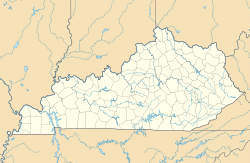James Rogers House | |
 | |
| Location | 6259 Sycamore St. Belleview, Kentucky |
|---|---|
| Coordinates | 38°59′7″N84°49′30″W / 38.98528°N 84.82500°W |
| Built | 1903 |
| Built by | John Presser, Et al. |
| Architectural style | Queen Anne |
| MPS | Boone County MRA |
| NRHP reference No. | 88003295 [1] |
| Added to NRHP | February 6, 1989 |
James Rogers House in Belleview, Kentucky is a Queen Anne-style farmhouse built in 1903. It was listed on the National Register of Historic Places in 1989. [1]
It is a modified T-form frame house with three cross-gables. It was built by carpenters John Presser and Henry Griffith and stonemason Timothy Hogan. It was one of six Queen Anne style buildings identified in Boone County in a survey. A smokehouse and a livestock barn on the property are also contributing buildings. [2]

